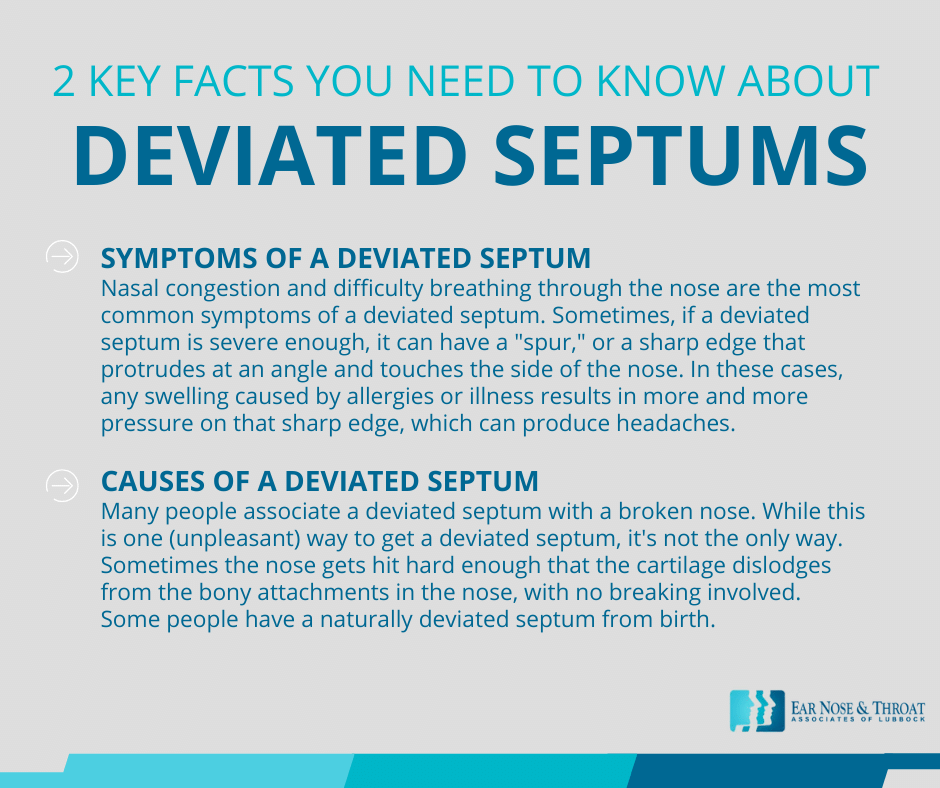Can a Balloon Sinuplasty Fix a Deviated Septum?

If you have a deviated septum, or if you suspect you do, you might be wondering what the best way to correct it is. Can a balloon sinuplasty fix a deviated septum?
Let’s take a look at exactly what a deviated septum is, how to treat it, and whether balloon sinuplasty can help.
What Is a Deviated Septum?
The nasal septum is the wall that divides your nose into two separate halves. The septum is part bone and part cartilage. When the septum gets off center, or deviates to one side, we call this a deviated septum.
Symptoms of a Deviated Septum
Nasal congestion and difficulty breathing through the nose are the most common symptoms of a deviated septum. If the deviation is bad enough, the patient may notice that one side of their nose is always blocked.
Typically, the more dramatic the deviation, the more dramatic the symptoms. Sometimes, if a deviated septum is severe enough, it can have a “spur,” or a sharp edge that protrudes at an angle and touches the side of the nose. In these cases, any swelling caused by allergies or illness results in more and more pressure on that sharp edge, which can produce headaches.
Nosebleeds, facial pain and snoring or noisy breathing at night can all be symptoms of a deviated septum. Some patients with a deviated septum even sleep on one side to help improve their breathing at night.
Causes of a Deviated Septum
Many people associate a deviated septum with a broken nose. While this is one (unpleasant) way to get a deviated septum, it’s not the only way.
You don’t necessarily have to get your nose broken to wind up with a deviated septum. Sometimes the nose gets hit hard enough that the cartilage dislodges from the bony attachments in the nose, with no breaking involved.
Some people have a naturally deviated septum from birth. They may never know they have it, or they may only start to notice a problem as they get older.
Cartilage never stops growing, and the cartilage in the septum is no exception. As people age, a slight deviation in the septum can become more pronounced as their cartilage grows.

What Is Balloon Sinuplasty?
Balloon sinuplasty is a minimally invasive office procedure that can help treat chronic sinusitis (sinus infections).
Patients can suffer from chronic sinusitis when the openings of their sinuses are too small. The narrow sinus openings swell shut easily, leading to the buildup of mucus and bacteria responsible for chronic sinus infections.
During balloon sinuplasty, the physician inserts a small balloon into the nose using a tiny tube with a camera and light attached. The doctor then inflates the balloon to open the sinus passageway and allow the sinus to drain more freely.
Cardiologists have used this technology for many years to dilate constricted coronary arteries. Today, ENT doctors have borrowed the technique and applied it along the same lines. Instead of temporarily inflating a balloon to dilate a constricted artery, they use it to widen a constricted nasal passageway.
Balloon sinuplasty is much less invasive than even endoscopic sinus surgery, and it can be done in an office visit with local anesthesia. Balloon sinuplasty also requires significantly less healing time than traditional surgery — usually one to two days.
Who Is a Candidate for Balloon Sinuplasty?
People who experience sinus infections three or more times per year that persist despite medical management can be good candidates for balloon sinuplasty. Other strong candidates include people with chronic sinusitis that never seems to fully resolve or respond to over-the-counter or prescription medications.
For patients who still have severe congestion after medical management, we perform a CT scan to better see what’s going on internally. This helps us determine whether or not balloon sinuplasty will be effective.
Are the Results From Balloon Sinuplasty Permanent?
Yes, balloon sinuplasty is a one-time procedure. The results from balloon sinuplasty provide long-lasting relief from the effects of constricted sinus passages.
Can Balloon Sinuplasty Fix a Deviated Septum?
The simple answer is no, balloon sinuplasty does not correct a deviated septum. The sinuplasty balloon only works on the sinus openings, not the septum; a septoplasty only deals with the septum.
However, though the two procedures are different, they can easily be performed at the same time.
If you have a deviated septum giving you trouble, and you also need balloon sinuplasty, scheduling the procedures together can be a good option. There’s no reason to undergo two separate procedures when it’s easy to fix both problems at the same time.
Do You Have a Deviated Septum?
If symptoms of a deviated septum are interfering with your life and your ability to breathe, give us a call. The entire team at ENT Associates of Lubbock loves helping our patients breathe easier.
The surgeons at ENT Associates of Lubbock are experienced in treating patients who have a deviated septum, those who need balloon sinuplasty, and everyone in between!
Dr. Cuthbertson is a physician at Ear Nose & Throat Associates of Lubbock. He joined the team at ENT Lubbock from Houston, where he was chief resident of the prestigious Bobby R. Alford Department of Otolaryngology at Baylor College of Medicine. He is board certified in Otolaryngology and Head & Neck Surgery and has quickly built a reputation, not only as an extremely skilled surgeon, but as an approachable and compassionate clinician adept in the newest standards and technologies. Learn more about Dr. Cuthbertson.
Categories:








